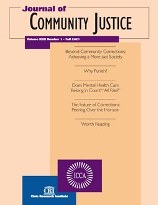Complete Issue
Author: Don Evans.
Source: Volume 17, Number 01, Fall 2007 , pp.1-32(32)

< previous article |return to table of contents
Abstract:
The lead article, based on a speech given by John Scott from the Ministry of Justice in the United Kingdom in August to the Universidad Internacional Menendez Pelayo, highlights the new penal, social, and health challenges that are currently facing probation. Scott poses five questions that he feels are important in analyzing efforts to have probation systems deliver effective services in the community. He begins by examining briefly the history of probation, then reviews what the community expectations are for probation, examines the evidence for effective practice in probation, and ponders the future directions for probation. He enlarges on this last point by presenting a vision for probation in Europe. In the second article in this issue, Claudia Newman addresses boundary issues in the professional-client relationship. Newman includes a variety of helpful examples, tips, and tools for the correctional worker’s guidance. The important work in community corrections is what happens in the interface between offender and worker. Questions about the use of professional power and expertise in working with offenders are not always addressed or acknowledged. This article is extremely timely and helpful, especially because there is a growing body of evidence that indicates the significance of the client-worker relationship in the successful outcome of an intervention. Jane O’Shaughnessy, installed as the new president of the International Community Corrections Association at the San Diego meetings in October, addressed the Ontario Halfway House Association conference held in Kingston, Ontario in September. In her comments on correctional issues and professional development, she noted the value of the exchange of ideas and information between the United States and Canada. O’Shaughnessy talked about shared policy concerns, program innovations, and the value of professional development for those who want to make a difference through their work. She called on the professionals attending the conference to become self-trainers in the principles and practices of the interventions they make. For O’Shaughnessy, competency means being able to design and enforce meaningful case plans with appropriate follow-through. Following up on the emphasis made by Scott and O’Shaughnessy on evidence-based practices, Thomas F. White, the director of operations for the Court Support Services Division of the State of Connecticut Judicial Branch, highlights the need to create leadership to facilitate implementation of an evidence-based agenda. Implementation of any approach to working with offenders involves leadership that is informed and prepared. White discusses key issues that leaders should address if they are to successfully move their agency toward an evidence-based practice. Evidence-based practice should be a continuous process of evaluation, and agencies need to understand the importance of the interrelationship between research and practice. On a recent radio talk show, I heard the uninformed comment that parole and other mechanisms for releasing offenders early from their “punishment” was done solely because of economic reasons! It is this type of coverage that makes it difficult to have an informed discussion on the merits of conditionally releasing offenders to community supervision. When the parameters of the discussion are formed by lack of knowledge of what is intended by early release strategies, it is no wonder that a bill such as the reentry bill takes so long to get passed. In an effort to center community corrections as a primary public safety service, the next two articles look at two aspects of this issue. In the first instance, Renée Collette, executive vice chair of the National Parole Board of Canada, looks at the parole system in Canada. Her article, a revision of a presentation made to a parole conference held in Wellington, New Zealand, last July, stresses the value of parole in a civilized society. Collette stresses the fact that parole is a key component of community corrections. After all, offenders come from the community and in almost every instance return to community. She sees community corrections and parole within it as a system of community protection. Her article looks at the parole decision making, the makeup of parole in Canada, what happens when things go wrong, and the challenges facing reintegration efforts. Turning to the issue of the reintegration of offenders, Kimora, in her article, discusses providing assistance in the reintegrative efforts of offenders released from prison. Kimora’s article begins by defining reentry and notes that it reflects the iron law of imprisonment—namely, that “they all come home.” Her article is an insightful discussion about providing offenders with incentives to change. It is a reminder that we are working with human beings and that relational approaches, which are at the core of community corrections, are important: “Reentry is a certainty but that success takes planning.”Keywords:
Affiliations:
1: Journal Editor.